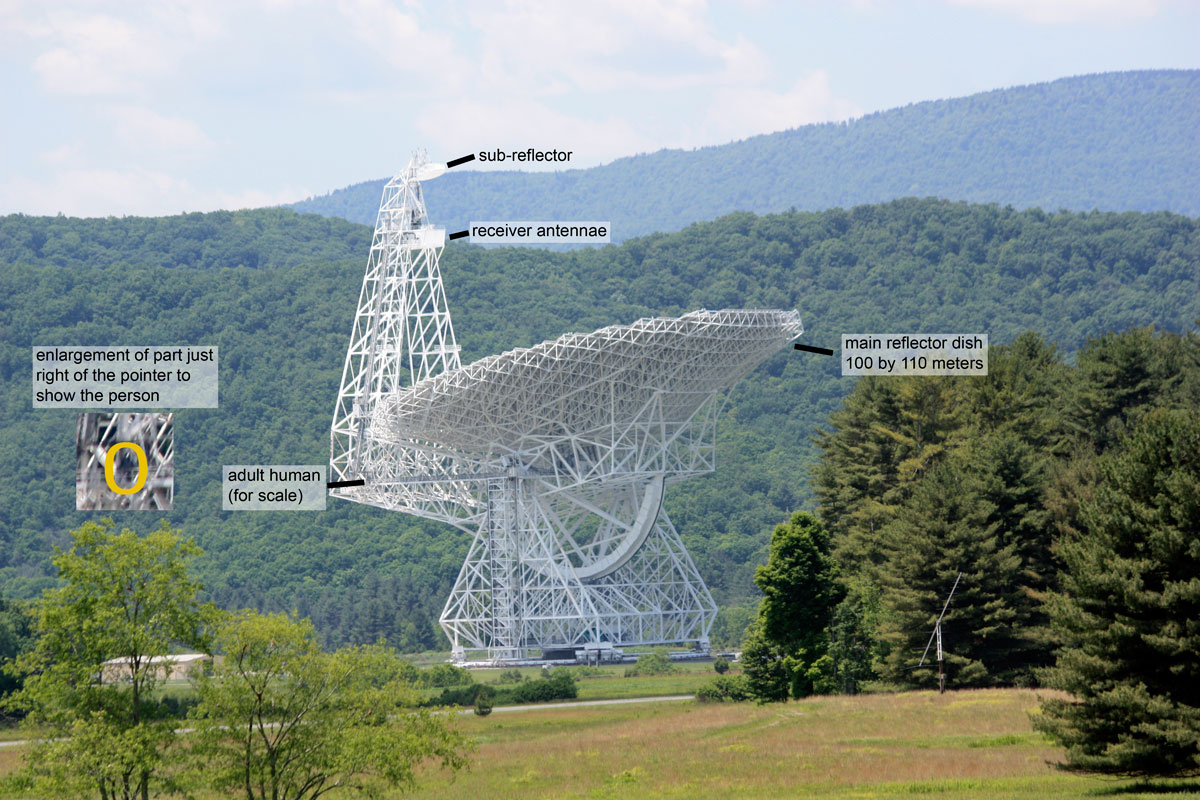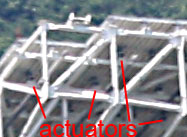

The Robert C Byrd Green Bank Telescope (GBT) is the largest fully steerable single-dish radio telescope in the world. The main reflector dish is 100 by 110 meters across or 2.3 acres (7854 square meters) of collecting area. The sub-reflector is 8 meters across. Radio waves bounce off the main dish and go up to either the sub-reflector or the Prime Focus receiver. If the sub-reflector is used, the radio waves bounce off it and are directed down to feedhorn antennae in the platform labeled "receiver antennae" in the image above. The main reflector dish consists of 2004 aluminum panels each about the size of a queen size mattress mounted on 2209 computer controlled actuators.
 An actuator is a motor-driven piston that can slightly raise or lower the corner of a panel. Each corner of the 2004 panels has an actuator fine-tuning the shape of the panel to maintain the accuracy of the overall parabolic shape to within 10–4 meter (100 microns). The GBT has a full complement of radio receivers suitable for both line (spectroscopy) and continuum (broad-band) work from frequencies as low as 290 MHz (1.03 meters wavelength) to as high as 100 GHz (3 millimeters) and eventually 115 GHz (2.6 millimeters)—the largest frequency range of any telescope in the world. Below frequencies of 4 GHz (7.5 centimeters), the actuators are not used because there is no improvement in the telescope's efficiency at those frequencies (7.5 cm wavelengths and larger). Above 4 GHz, the surface is adjusted as the elevation and azimuth are changed and also in response to shifting wind. If the wind is too great (I think it is 20 mph), observations are not taken because the buffeting would significantly downgrade the data quality. Also, at frequencies above about 10 GHz, water vapor becomes a significant absorber, so observing at about 10 GHz and above must be done in clear, cool, and dry weather conditions.
An actuator is a motor-driven piston that can slightly raise or lower the corner of a panel. Each corner of the 2004 panels has an actuator fine-tuning the shape of the panel to maintain the accuracy of the overall parabolic shape to within 10–4 meter (100 microns). The GBT has a full complement of radio receivers suitable for both line (spectroscopy) and continuum (broad-band) work from frequencies as low as 290 MHz (1.03 meters wavelength) to as high as 100 GHz (3 millimeters) and eventually 115 GHz (2.6 millimeters)—the largest frequency range of any telescope in the world. Below frequencies of 4 GHz (7.5 centimeters), the actuators are not used because there is no improvement in the telescope's efficiency at those frequencies (7.5 cm wavelengths and larger). Above 4 GHz, the surface is adjusted as the elevation and azimuth are changed and also in response to shifting wind. If the wind is too great (I think it is 20 mph), observations are not taken because the buffeting would significantly downgrade the data quality. Also, at frequencies above about 10 GHz, water vapor becomes a significant absorber, so observing at about 10 GHz and above must be done in clear, cool, and dry weather conditions.
Some other basic stats of the telescope: it stands about 148 meters tall (485 feet) at the top of the tower holding the sub-reflector. It weighs 7.7 million kilograms (17 million lbs) which is equal to 20 fully loaded Boeing 747s. Despite that huge mass, the GBT can be pointed to within an accuracy of one arc second (recall that one arc second is about the angular size of the tiny ball in the tip of a ballpoint pen when viewed from across the length of a football field). There are 13,000 steel beams, all welded together, supporting the main dish.
Previous -- Next -- Return to start of tour
last updated: September 13, 2011